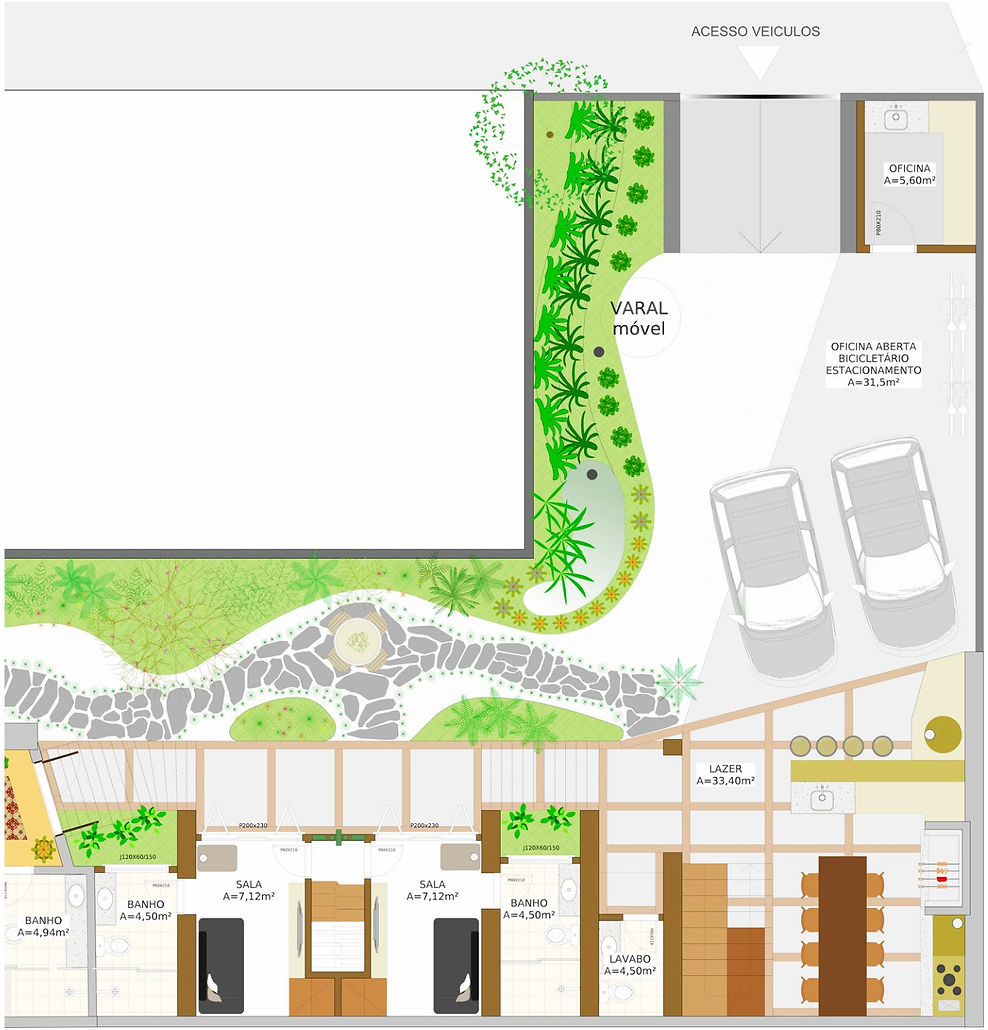BIO ARCHITECTURE | BIO ARQUITETURA
New built area | Nova área construída

PLANTA BAIXA TÉRREO

PLANTA BAIXA 2° PAV.
This project is inspired by Bio Architecture, respecting the ancient techniques of construction, valuing the history of the buildings and the city and using bioclimatic and local raw materials for better quality construction coupled with lower impact on the environment.
What are the advantages of building with earth?
The Bioconstruction is an ancient technology, used by man for 10,000 years; but that in the past 100 years, was being abandoned and stigmatized as a marginal and precarious technology. Its up to us to seek the path of balance, using the latest technologies in conjunction with the earth construction, which has several advantages:
-
Availability: is a naturally available material almost anywhere in the world;
-
CO2 emissions: almost zero in its "manufacturing" (only natural emissions), unlike cement sending tons and tons of gases in the blast furnaces;
-
Recycle: the earth wall is 100% reusable, that is, you can take down a wall and reuse all the land to another wall. In addition to the earth walls, we reuse glass bottles, wooden doors and windows and other materials that would otherwise be discarded as waste.
-
Durability: no earth construction in Iran which has two thousand years. Want more examples? How about the Taj Mahal (made of earth, with bamboo structure) ... or the Great Wall of China (all filling made with earth, compacted by the cavalry's own Chinese army). Brazilian examples? More than 40% of the buildings, as centuries-old churches, registered by IPHAN are of adobe (raw mud bricks) or wattle and daub. The behavior of buildings with cement are still unknown, because the technology is new in our history (150 years since its invention).
-
Comfort: earth walls to "breathe", ie, air and moisture exchange with the internal and external environment, and when construction is planned taking into account the weather, the sun's position throughout the year and the direction of the winds, we can keep the interior environment of the construction in a thermal comfort zone, around 24 ° C;
-
Health: the exchange of moisture and air to the environment, and the ability to maintain the temperature in a comfort zone in free air conditioning and mold; in earth walls no volatile chemicals, which can cause respiratory problems; Furthermore, the land acts as a natural barrier against electrosmog ("pollution" radiation antenna and electronic);
-
Waste generation: does not generate debris during construction;
-
Cooperation: the buildings can be made in joint effort with the participation of the local community.
Esse projeto é inspirado na Bio Arquitetura, respeitando as técnicas milenares de construção, valorizando a história das construções e da cidade e utilizando a bioclimática e matérias-primas locais para melhor qualidade da edificação aliado ao menor impacto no meio ambiente.
Quais são as vantagens da construção com terra?
A Bioconstrução é uma tecnologia milenar, utilizada pelo homem há 10 mil anos; mas que, nos últimos 100 anos, foi sendo abandonada e estigmatizada como uma tecnologia marginal e precária. Cabe a nós buscarmos o caminho do equilíbrio, utilizando tecnologias mais recentes em conjunto com a construção com terra, que possui várias vantagens:
-
disponibilidade: é um material naturalmente disponível em quase qualquer parte do planeta;
-
emissão de CO2: quase nula em sua “fabricação” (apenas emissões naturais), diferentemente do cimento que emite toneladas e toneladas de gases nos alto fornos;
-
reutilização: a parede de terra é 100% reutilizável, ou seja, é possível derrubar uma parede e reutilizar toda a terra para fazer outra parede. Além da terra, reutilizamos garrafas de vidro, portas e janelas de madeira e outros materiais que seriam descartados como lixo.
-
durabilidade: há construções de terra no Irã que tem dois mil anos. Quer mais exemplos? Que tal o Taj Mahal (feito de terra, com estrutura de bambu)… ou a Muralha da China (todo o preenchimento feito com terra, compactada pela cavalaria do próprio exército chinês). Exemplos brasileiros? Mais de 40% dos prédios, como igrejas centenárias, registrados pelo IPHAN são de adobe (tijolos de barro crus) ou pau-a-pique. O comportamento das construções com cimento ainda são uma incógnita, pois a tecnologia é recente em nossa história (150 anos desde seu invento).
-
conforto: as paredes de terra “respiram”, ou seja, trocam ar e umidade com o ambiente interno e externo, e quando a construção é planejada levando em consideração o clima, a posição do sol ao longo do ano e a direção dos ventos, podemos manter o ambiente interior da construção numa zona térmica de conforto, ao redor de 24°C;
-
saúde: a troca de umidade e ar com o ambiente, e a capacidade para manter as temperaturas numa zona de conforto nos livram do ar condicionado e do mofo; nas paredes de terra não há produtos químicos voláteis, que podem causar problemas respiratórios; além disso, a terra atua como uma barreira natural contra o eletrosmog (“poluição” por radiação de antenas e eletrônicos);
-
geração de resíduos: não gera entulhos durante a construção;
-
cooperação: as construções podem ser feitas em mutirão, com a participação da comunidade local.
REFERÊNCIAS

Project by Arq.Cristina Xavier

